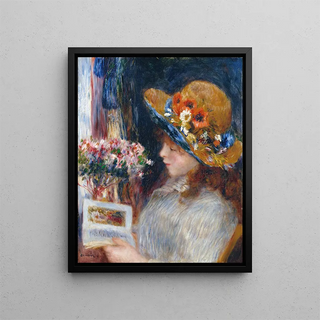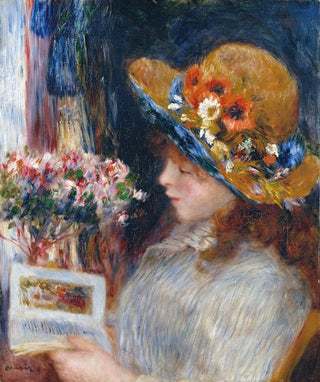Art print | Girl Reading - Pierre-Auguste Renoir


View from behind

Frame (optional)
In the fascinating world of impressionist art, the artwork "Fille lisant" by Pierre-Auguste Renoir stands out for its delicacy and poetry. This painting, created in 1876, invites the viewer to immerse themselves in a suspended moment, where childhood innocence meets the beauty of nature. The scene depicts a young girl, absorbed in reading a book, surrounded by a peaceful and luminous atmosphere. The choice of subject, a child immersed in her imaginary world, resonates with an universality that transcends time. Renoir succeeds in capturing not only childhood innocence but also the intimacy of a shared moment between art and contemplation.
Style and uniqueness of the artwork
Renoir's style is characterized by his masterful use of color and light. In "Fille lisant," pastel tones and delicate nuances create a visual harmony that draws the eye and soothes the mind. The light, omnipresent, seems to dance across the canvas, enveloping the young girl in a warm aura. Renoir excels in depicting textures, whether through the child's clothing or the surrounding vegetation. Each brushstroke is a caress, every detail carefully thought out to evoke an atmosphere of serenity. This painting is not limited to a simple representation; it is an invitation to feel, to marvel at the beauty of everyday life, and to rediscover the magic of simple moments.
The artist and his influence
Pierre-Auguste Renoir, an emblematic figure of Impressionism, knew how to mark his era with his innovative approach to painting. By moving away from academic conventions, he paved the way for a new way of perceiving the world. His influence extends far beyond his time, inspiring many artists who followed in his footsteps. Renoir always sought to capture life in all its splendor, to immortalize human emotions and social interactions. His artistic vision, centered on beauty and the joy of living, contributed to redefining art standards and broadening the horizons of creation.

Matte finish

View from behind

Frame (optional)
In the fascinating world of impressionist art, the artwork "Fille lisant" by Pierre-Auguste Renoir stands out for its delicacy and poetry. This painting, created in 1876, invites the viewer to immerse themselves in a suspended moment, where childhood innocence meets the beauty of nature. The scene depicts a young girl, absorbed in reading a book, surrounded by a peaceful and luminous atmosphere. The choice of subject, a child immersed in her imaginary world, resonates with an universality that transcends time. Renoir succeeds in capturing not only childhood innocence but also the intimacy of a shared moment between art and contemplation.
Style and uniqueness of the artwork
Renoir's style is characterized by his masterful use of color and light. In "Fille lisant," pastel tones and delicate nuances create a visual harmony that draws the eye and soothes the mind. The light, omnipresent, seems to dance across the canvas, enveloping the young girl in a warm aura. Renoir excels in depicting textures, whether through the child's clothing or the surrounding vegetation. Each brushstroke is a caress, every detail carefully thought out to evoke an atmosphere of serenity. This painting is not limited to a simple representation; it is an invitation to feel, to marvel at the beauty of everyday life, and to rediscover the magic of simple moments.
The artist and his influence
Pierre-Auguste Renoir, an emblematic figure of Impressionism, knew how to mark his era with his innovative approach to painting. By moving away from academic conventions, he paved the way for a new way of perceiving the world. His influence extends far beyond his time, inspiring many artists who followed in his footsteps. Renoir always sought to capture life in all its splendor, to immortalize human emotions and social interactions. His artistic vision, centered on beauty and the joy of living, contributed to redefining art standards and broadening the horizons of creation.






